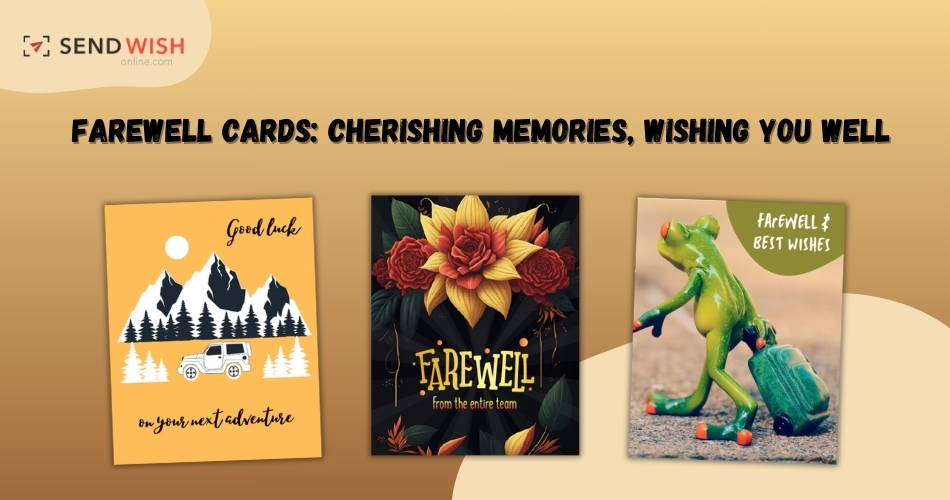Just as physical goodbye cards foster special memories and connections, a carefully designed virtual farewell card preserves the sentiment of personal recognition even when colleagues are scattered around the world. Digital cards offer more flexibility for incorporating multimedia elements like photos, videos, and animated graphics. They also make it easy to share cards more widely within an organization compared to physical cards that stay on one’s desk. The right combination of visuals, text, and interactive features can elevate a virtual farewell card above a simple email or chat farewell.
When designing a virtual card, less text is often more. Short, heartfelt messages paired with relevant images, GIFs, or voice recordings keep the card feeling personal yet breezy to consume digitally. Including inside jokes or references to shared projects in photos and videos brings back special memories in a visual format. Consider including interactive elements like clickable links to collateral from big milestones or polls to involve colleagues. Customizable templates allow senders to personalize the card with their own photos, colors, and layouts for a truly bespoke feel.
Q
As with physical cards, including well-wishes for the future, words of wisdom, or ways to stay connected preserves the relationships built over time working together. Sharing contact details across platforms like LinkedIn, personal email, phone numbers or scheduling tools like Calendly make it seamless to maintain those ties going forward. You might also include a short bio or link to your new company’s website to keep colleagues updated on what’s next after leaving the organization.
For remote teams that never met face-to-face, virtual cards offer a creative outlet to get to know someone on a deeper personal level before they depart. Short video messages, audio notes, or candid photos help attach real identities and personalities to colleagues who may have only ever interacted through screens. Highlighting inside jokes, hobbies or personal anecdotes gives remote colleagues a glimpse into each other as whole human beings beyond work profiles.
While technology enables remote goodbyes, a thoughtful virtual card still requires the human touch of time, care, and personalization. With some creative planning, digital farewells can feel just as heartfelt as in-person celebrations, preserving meaningful connections in a workplace that now spans every timezone. As remote and hybrid models become the norm, virtual farewell cards deserve recognition as an impactful way to say goodbye with care, respect and appreciation, even from a distance.
Taking Farewell Cards Digital – Additional Considerations
While virtual cards offer new creative opportunities, there are also additional factors to consider compared to physical cards. Things like file size limits, compatibility across devices and platforms, privacy and security all require careful planning to ensure the card can be seamlessly accessed and appreciated.
File Size & Formats: Large multimedia cards may hit file size limits for sharing via email or chats. Optimizing photos, cropping videos and choosing the right file formats keeps the card lightweight while maintaining quality. Common cross-platform formats like JPG, PNG, MP4 are safest bets for wide compatibility.
Sendwishonline.com simplifies the coordination of group cards by providing a user-friendly interface where multiple contributors can add their messages, photos, and even videos
Device Friendly Design: Consider how the card will appear on both desktop and mobile. Simple, scroll-based layouts translate better than complex designs requiring specific screen sizes. Accessibility features like alt text for visuals ensure the card is inclusive for users of assistive technologies.
Privacy & Security: Sensitive data like personal contact details or photos should have privacy controls. Secure sharing options via internal systems or password-protected links prevent accidental public exposure. Brief disclaimers about information use help set expectations of confidentiality.
Interactivity: While engaging interactivity enhances the experience, not all platforms support interactive elements. Simple, static alternatives maintain the sentiment when interactivity isn’t feasible. Compatibility testing across systems prevents broken features or content.
Archiving & Access: Will cards be stored in company systems for future access? Digital archives require organized metadata, versioning and backups for longevity. Time-bound links or expiring content may be preferable to permanent archives in some contexts.
Customization: Well-designed templates allow personalization while reducing design overhead. Default options maintain consistency while enabling customization of colors, photos and text for unique personal touches at scale.
Incorporating these additional considerations helps virtual cards fulfill their potential as heartfelt, interactive and accessible digital tributes even when colleagues are remote. With some forethought to platform support, privacy and future access, digital farewells can feel just as meaningful as in-person goodbyes.
Include Multimedia Memories
Beyond just photos, consider adding other multimedia elements that capture special memories. Short video clips of inside jokes in action or voice messages expressing gratitude can add a personal touch. Screen recordings of big project milestones or presentations bring remote work collaborations to life. Be sure to optimize file sizes for smooth sharing.
Get Interactive
Quizzes about office trivia, polls to have colleagues share favorite moments, or embedded links to bonus content keep the card lively. Interactive elements don’t need to be complex – even simple clickable buttons can engage recipients in the experience. Test compatibility across platforms before including interactivity.
Personalize at Scale
Well-designed templates with customization options allow for personal touches even when sending cards to large teams. Default colors, images and text areas can be modified per recipient easily. Placeholders for name/photo swaps maintain a consistent brand while feeling bespoke.
Consider the Recipient
Tailor the card experience based on the audience. Cards for remote colleagues may require more context than those for in-office coworkers. Senior leaders appreciate brevity; peers enjoy humor and informality. Knowing recipients’ roles and relationship to the departing colleague guides a meaningful tone and focus.
Make it Memorable
Small surprises keep recipients engaged. Hidden easter eggs, bonus content unlocked by sharing the card, or time-bound features create FOMO and excitement. Memorability is key for cards to have impact beyond the first view and stay top of mind longer term.
